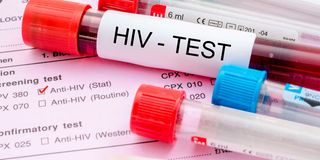Concern as 10 counties record surge in HIV cases

Out of the 17,680 new HIV infections among adults in Kenya, 41pc are aged between 25 and 34.
Ten counties have recorded a surge in HIV prevalence, posing a threat to the push to attain zero infections by 2027, a State agency has revealed.
The National Syndemic Diseases Control Council (NSDCC) has flagged Homa Bay, Siaya, Kisumu, Migori, Busia, Kisii, Mombasa, Samburu, Vihiga and Uasin Gishu as the most affected counties in its latest report estimates.
According to the data, Homa Bay is grappling with a staggering 15.2 per cent increase in new cases, while Siaya is experiencing a significant 13.2 per cent rise.
Kisumu is facing a worrisome 14.5 per cent increase in HIV infections while Migori is reporting a 9.7 per cent increase. Mombasa has a 4.6 per cent increase followed by Kisii at 4.4 per cent.
Other counties that have recorded increases are Samburu (4.3 per cent), Vihiga (4.2 per cent), and Uasin Gishu (3.7 per cent).
Speaking at a workshop in Machakos on Sunday, November 5, NSDCC Programme Officer Douglas Bosire pointed out that, despite a significant reduction in new HIV infections, there is an alarming increase in cases.
He explained that in Nyanza, the culture of non-circumcision is fuelling the rise, while in the arid and semi-arid lands (Asals), the practice where the male head of the household must give permission for family members to visit hospitals contributes to the spread.
Mr Bosire emphasised that stigmatisation in Asal areas is more pronounced than other regions.
He said Homa Bay County, for instance, is contending with a substantial HIV prevalence rate of 15.2 per cent because of low levels of stigmatisation, in stark contrast to Garissa and Wajir counties, which report a significantly lower prevalence of just 0.1 per cent.
“In this area, people do not hesitate to undergo HIV testing, which has contributed to achieving a five per cent reduction in new infections,” said Mr Bosire.
“However, in the Asal regions, a contrasting scenario persists. Stigmatisation remains a significant challenge, and individuals here are often reluctant to openly discuss HIV due to cultural barriers,” he added.
According to the statistics, out of the 17,680 new HIV infections among adults, 41 per cent are aged between 15 and 24.
Mr Bosire noted that the diversification doesn't stop at demographics but extends to various populations, including sex workers, truck drivers, men who have sex with men, members of fishing communities, prisoners, and users of intravenous drugs.
Shockingly, he said, these specific groups face HIV prevalence rates many times higher than the national average.
“Despite our success, the younger people are a stumbling block in our quest to end new HIV infections by the year 2027. People aged 29 years and below account for at least 61 per cent of all new HIV infections,” he said.
Brought under control
As the country gears up to celebrate World Aids Day, Mr Bosire noted that Kenya's efforts to combat HIV/Aids may be jeopardised unless the increasing rates of new infections among adolescents and young adults are brought under control.
Nonetheless, Mr Bosire said, Kenya is making significant progress in the reduction of new HIV infections. He pointed out that over the past decade, there has been a remarkable 78 per cent decrease in new HIV infections, dropping from 101,448 cases in 2013 to 22,154 in 2022.





